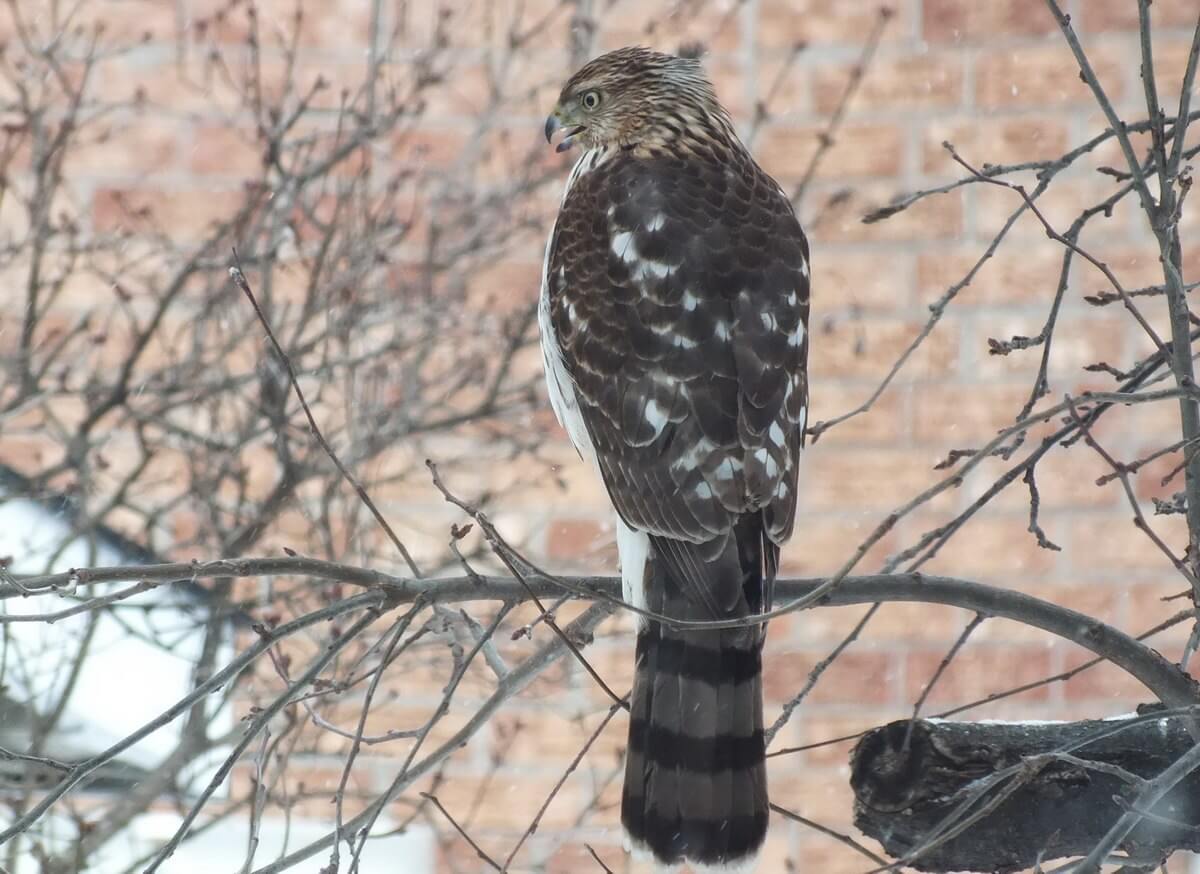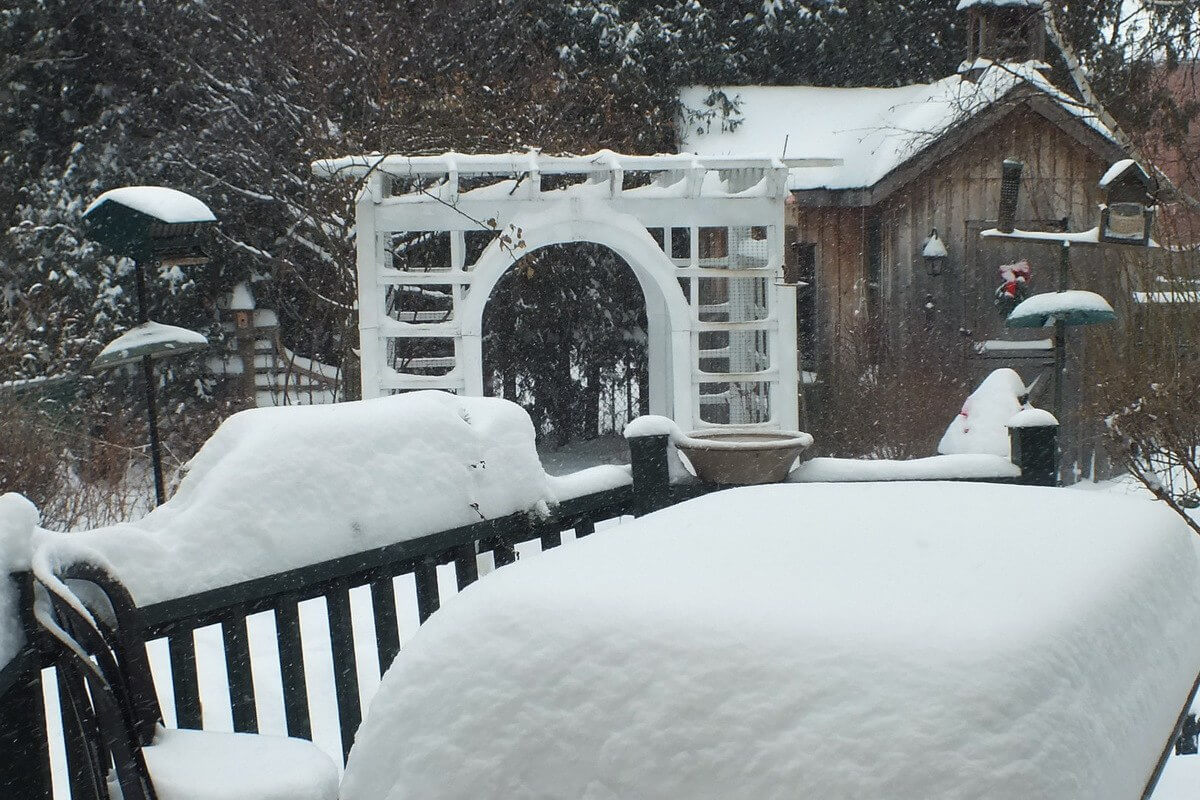Sharp-shinned Hawk Suffers Through Toronto Snowstorm
As another winter storm hit Toronto, many of us were, without a doubt, contemplating how we would weather the onslaught of another heavy snow. Well, this poor unfortunate Sharp-shinned hawk ( Accipiter striatus) was not faring very well in my backyard as it looked for some unsuspecting prey. Birds seem to know when nasty weather is brewing, and this bird has been visiting my property frequently, likely hoping for an easy catch to sustain him while the blizzard unfolded.
When it flew in, with the snowstorm just beginning to ramp up, one of our bird feeders looked like this, weighed down with snow and no birds in sight.
Had the hawk only arrived two hours prior to the onset of the snowstorm, it would have found these guys hanging around the same feeder.
But it’s timing was off, and so the sharp-shinned hawk just sat in our apple tree and searched the boughs of our cedar trees from afar.
The birds had quickly made themselves scarce, our suet feeder sat empty except for the collecting snow.
Two hours before the hawk’s arrival, the same suet feeder was serving up breakfast to a nuthatch.
The hawk was attentive to its surroundings, so I kept hidden behind my camera as I monitored it through my kitchen window.
In this video, you get a chance to observe the hawk on its perch.
Suddenly, the hawk lifted its tail revealing the tell-tale pencil-thin legs of the sharp-shinned variety of hawk. I thought it was about to depart.
Instead, the hawk relieved itself, which, I think, pretty much summed up its thoughts about hoping to find something to eat in my snowy backyard.
Moments later, the sharp-shinned hawk actually did prepare for liftoff.
In a blur of wings and feet, the sharp-shinned hawk took to the air.
The hawk’s talons can be seen neatly tucked up under the spread tail feathers. I am sure they will soon make contact with some small prey, but hopefully not in my backyard. I am too fond of the cardinals, juncos, nuthatches and woodpeckers that frequent my feeders.
The wide extension of the hawk’s wings propelled it quickly out of the apple tree, and then it disappeared over top of the neighbours’ houses.
With more than 12 inches of snow already accumulated on my patio table, we sit and wait for the storm to end. Maybe then, the sharp-shinned hawk will have an easier time of finding something to eat.
In the meantime, a flock of sparrows, together with the juncos, nuthatches and cardinals, had gathered once again at my feeding stations while the snow swirled around them.
Frame To Frame – Bob and Jean


















Beautiful hawk images.
Since it did not migrate, it probably will not survive the winter. I know that western warbling vireo had to perish in the snowstorm that happened the week after I saw it.
thanks, Paul. We feel blessed when any birds come to our bird feeders even though I do fear for the little songbirds whenever a hawk or kestrel shows up.
Sharp-shinned hawks are migratory. They will spend their winters in Mexico, Central America, and the Greater Antilles. So either this hawk was not well enough to migrate, or it was never taught to do so. During winter I have seen birds that usually migrate, not do so. One time an Audubon’s warbler, which did not make it down to Central America. Another time, a western warbling vireo, which did not make it to Mexico. It was sad, because this vireo leaped onto the lapel of my jacket, and was looking under it for insects. A snowstorm set in a week later, and I knew it did not survive.
It must have been sad to learn that the vireo did not survive. We believe that this particular sharp-shinned hawk managed to weather the storm as well as the subsequent one we experienced last week because the hawk, once again, visited our backyard since then. It was right about lunchtime. After sitting on the deck railing for a few minutes, the hawk dove into the boughs of our discarded Christmas tree in search of sparrows that had taken refuge there.
If a migratory species does not migrate, it is not always a death sentence for it. There is a 50-50 chance of it surviving. This sharp-shinned hawk was probably one of those that did survive.
Yes, I agree. There is no way of knowing if the Sharp-shinned Hawk that appeared in my backyard most recently was the same one as was there previously, but my best guess is that it is one and the same. Its territory seems to include our neighborhood park as well.